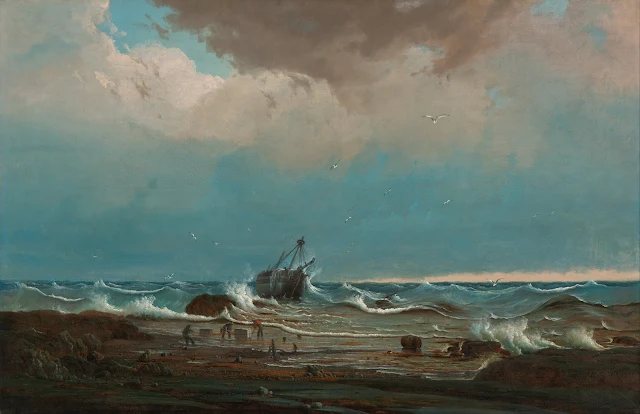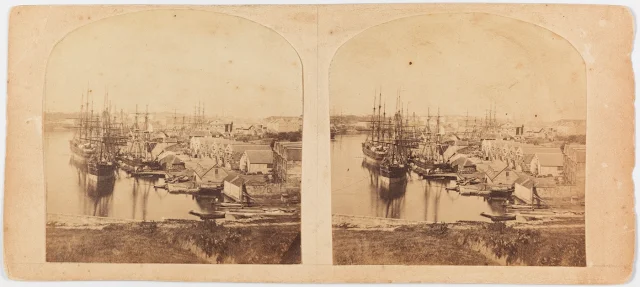ROBERT BROOKS ship owner and wool merchant
ROBERT TOWNS and THOMAS CHAPMAN shipping agents


On left: Robert Towns, merchant and entrepreneur, 1873 / Creator Freeman Brothers.
Call Number P1 / 1797. Digital Order No. a4364097.
Mitchell Library State Library NSW
On right: Honourable T D Chapman
Description:1 photographic print [undated, unattributed]
ADRI: NS407-1-19
Source: Archives Office of Tasmania
British ship owner, wool merchant, director of the Union Bank of Australia (UBA), investor in the London Wool Docks, and eventual owner of the Woodcote estate near Epsom (UK), the remarkable Robert Brooks (1790-1882) voyaged to Australia just once, on board the Elizabeth, departing Portsmouth (UK) on 9th March 1823, dropping anchor at Hobart, Van Diemen's Land, on 12th July 1823, 125 days out. From this very profitable adventure in partnership with Ranulph Dacre, buying and selling timber, wool, sea elephant oil, and colonial produce on the inward and outward voyages, he established early a reliable network of agents with men such as Anthony Fenn Kemp in Hobart and Robert Campbell Jr in Sydney. Ranulph Dacre was the owner of several ships, including the Wave which Captain Edward Goldsmith commanded to Van Diemen's Land during the 1830s to the early 1840s, and with Alexander Fotheringham, the whaler Porteous. Fotheringham also established the first patent slip at Darling Harbour. The success of this and other early ventures was short-lived, however, when Dacre faced bankruptcy, leading Brooks to seek out Sydney businessman Robert Towns (1794-1873) as his chief agent for two enterprises: expansion into the Australian wool trade, and promotion of assisted migration to Australia. The latter contributed to the rapid development of trade to the colonies in the 1830s but also led to a glut and slump in trade which did not recover until the mid 1840s.
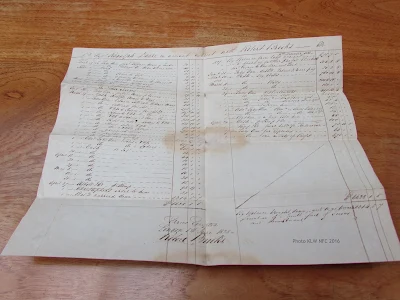
Dacre's account 1st June 1828, signed by Robert Brooks

"Errors Excepted ": detail of Dacre's account (above)
Signature of Robert Brooks, London, 1st June 1828

[Above]: Letter from Robert Brooks to Ranulph Dacre, 28th September 1841. Very large sums of money are discussed here, with mention of the accounts of several women - Miss Davies, Mrs Staples, Mrs Weaver, Miss Reynolds, and Mrs Battenshaw,
Source of items above: Robert Towns & Co - Records, 1828-1896
National Library of Australia Call Number MLMSS 307
184: Papers, including business letters from Robert Lodge and Robert Brooks to Robert Towns and Co; cargo manifestoes, the 'Eagle', 'Robert Matthews', 'Parrock Hill'; passenger list 'Duke of Roxburgh'
Photos copyright © KLW NFC Imprint 2016
The long term success of Robert Brooks' shipping and pastoral investments depended heavily on the trust he placed in his agents at colonial ports, and on his delegation of all responsibility to his ships' masters. "Freight payable in the colony" appeared frequently on his cargo manifests. Between 1834 and 1836 he purchased eight vessels, all second-hand. Between 1844 and 1846, his shipping purchases included the Parrock Hall, (Goldsmith, master) the Victor, the Kinnear, the Angelina (Goldsmith, master) , the North Briton, the Eagle, the William Wilson, and most important of all, the Rattler, built and bought specifically for Captain Edward Goldsmith (Broeze, p. 150, Table 8.6).

Brooks' shipping purchases
Captain Goldsmith commanded the Parrock Hall, the Angelina and the Rattler
Broeze, p. 150, Table 8.6
From 1845, Hobart became Brooks' third major loading port, in no small measure because of initiatives taken on the spot by his agent Thomas Chapman (1815–1884). As his biographer Frank Broeze tells it, (pp. 153-4) -
Captain Goldsmith of the Parrock Hall making his first voyage for Brooks, through his connection Thomas Chapman arranged that the Aden loaded home at Hobart. at the excellent rate of 1½ d per 1lb wool and £5 5s per ton for whale oil .... The new link proved so satisfactory that ... Brooks turned incidental deployment into permanent commitment. Building on Captain Goldsmith's reputation and the strength of his connections with Devitt & Moore in London and Thomas Chapman at Hobart, he bought a new ship for Goldsmith, to be employed as a 'regular trader' i.e. on a permanent shuttle service between London and Hobart. The Rattler, of 522 tons, NM, was a large ship for the Hobart trade and at £5750 was Brook's most expensive yet. But he estimated the capabilities of his agents correctly. Devitt & Moore despatched the ship with sufficient rapidity to ensure that her arrival at Hobart was perfectly timed for the coming wool season. She reached Hobart on 11 November 1846 and was immediately advertised as a 'new and remarkable fast barque' to sail in early January. Despite her size, Chapman loaded her in a little over two months.Captain Edward Goldsmith and the Rattler were a fixture in the Hobart trade, having completed six consecutive seasons from 1846/7 to 1851/2. Thomas Chapman's agency ensured a rapid turnaround. but the ship and its master gradually lost time against the 'seasonal clock', arriving at London Docks on 17 May, 8 June, 23 June, 1 July, 16 July and 17 July in consecutive seasons. Although put on berth at Hobart in 1852 awaiting cargo, Brooks had few choices but to accept a charter of migrants to Sydney. The Rattler was sold along with the Bangalore on its return to London in 1853 (Broeze, p. 223) under the command of Captain Wardell [Waddell?]
Until 1851/52 the Rattler maintained an annual shuttle service based on the rhythm of successive wool seasons. In principle, such a schedule, supported by influential brokers at either side, formed the solution to the problem of the British shipowner in finding continuous employment in the Australian trade. The slightest delay in loading or on the passage could fatally disturb the annual rhythm .... In Sydney it occurred only rarely that a ship loaded home in more than two successive years.... But only at Hobart were several independent freight carriers able to achieve sustained shuttle employment. With a shorter sea passage to and from Britain and a more compact hinterland than Sydney the chances of delays were much reduced (Broeze 1993:153-4).
VOYAGES on the RATTLER, Captain Edward Goldsmith, Master:
1846: arrived Hobart from London, 14th November 1846, departed 21st January 1847.
1847: arrived Hobart from London, 11th November 1847, departed 29th January 1848.
1848: arrived Hobart from London, 4th December 1848, departed 25th February 1849.
1849: arrived Hobart from London, 27th November 1849, departed 26th February 1850.
1850: arrived Hobart from London, 13th December 1850, departed 19th March 1851.
Captain Alexander Stewart Wardell/Waddell, a neighbour of Captain Edward Goldsmith in Davey Street Hobart, Tasmania, took command of the Rattler on Captain Goldsmith's return to London in July 1851, departing Plymouth on 14th September 1851, arriving at Hobart on 13th January, 1852. Within a month the Rattler under Commander Wardell/Waddell was preparing departure for London, per this advertisement of 31st January, 1852:
Source: Hobarton Guardian, or, True Friend of Tasmania (Hobart, Tas. : 1847 - 1854) Sat 31 Jan 1852 Page 2 Advertising
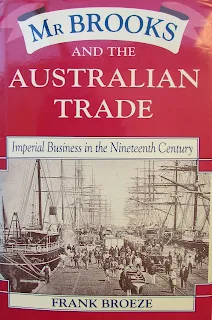
Reviewed as "this book is a case study of principal-agent theory" (International Bibliography of Business History, 2013)
Frank Broeze's biography: Mr Brooks and the Australian trade : imperial business in the nineteenth century /
Frank Broeze. Carlton, Vic. : Melbourne University Press, 1993. xi, 375 p., [12] p. of plates : ill., map, ports. ; 24 cm.
Captain Goldsmith, with wife Elizabeth (Day) Goldsmith and their two sons Richard Sydney and Edward jnr Goldsmith were to spend extended periods during the next two years in the colony at their residence, 19 Davey Street Hobart, while Captain Goldsmith embarked on the construction of the SS Kangaroo, a vehicular twin ferry designed for travel between Hobart Town and the eastern shore of the River Derwent. He also built a number of smaller vessels including a 25 ton schooner, and commenced the first phases of a patent slip at his shipyard on the Queen's Domain before mitigating circumstances arrested its progress, caused in principal part by extensive delays in obtaining adequate finance and materials from the colonial government. The death of first-born son Richard Sydney Goldsmith, 24 years old in 1854, from typhoid fever while working at the Union Bank in Hobart was no doubt the tipping point. Captain Edward Goldsmith, wife Elizabeth and younger son Edward Goldsmith jnr departed Tasmania on the Indian Queen as passengers bound for Liverpool in February 1856, never to return to Tasmania. They settled back at Gad's Hill House, in the village of Higham, Kent (UK), where they found their new neighbour was none other than Charles Dickens. Captain Goldsmith's nieces, Elizabeth Rachel Day and Mary Sophia Day, daughters of his brother-in-law, former first mate and navigator Captain James Day, remained in Hobart. By 1871 Elizabeth Rachel was married to photographer Thomas J. Nevin, and by 1878, her younger sister Mary Sophia was married to mariner Captain Hector Axup.
Original Documents
These original documents are held in two Australian collections: the National Library of Australia and the Mitchell Library, State Library of NSW. One idiosyncratic aspect of Robert Brooks' character commented on by all who conducted business with him was the meticulous care he took with double entry bookkeeping at his counting house, where he only ever employed a handful of clerks (Broeze, p.294). Click to view examples in these photographs taken from the Australian collections of Brooks' accounts and correspondence with agents and ships' masters.
THE NATIONAL LIBRARY of AUSTRALIA

Records of Robert Brooks and Co.
National Library of Australia Manuscript Collection NLA MS 2381
Photo copyright © KLW NFC Imprint 2016
Robert Brooks and Co & Robert Towns and Co. (1822-1890).
Records of Robert Brooks and Co.,
MS 2381 comprises 11 volumes of records documenting the business affairs of merchants and wool importers, Robert Brooks and Co. in 1841-1876. The collection includes two letterbooks, two journals and two ledgers, among other records (2 boxes, 2 fol. boxes, 1 elephant folio). Further business correspondence, 1862-1890, is available on microfilm. MS 2381-Records of Robert Brooks and Co., 1822-1890 [manuscript].
The ship Angelina, Captain Goldsmith master, 1845
Notices: Captain Goldsmith, master of the Angelina January 1846 off Towns Wharf
Source:The Shipping Gazette and Sydney General Trade List (NSW : 1844 - 1860)
Sat 24 Jan 1846 Page 21 SHIPS IN HARBOUR.


The ships Parrock Hall (1844) and Rattler (1846), Captain Goldsmith, master

Captain Edward Goldsmith's accounts


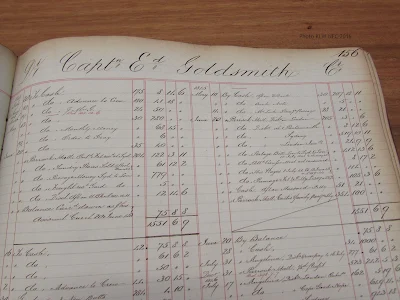

The ship Janet Izat or Izatt, Captain Goldsmith master

Accounts for Robert Towns, agent at Sydney

The ship Parrock Hall at Sydney 1844, Captain Goldsmith master
Consignors and consignees




Captain Edward Goldsmith's accounts


Edward Bisdee of Van Diemen's Land, submitted a bill to Brooks to pay a Mr Muddle twenty pounds, nineteen shillings and three pence.

The ship Rattler, Captain Edward Goldsmith, master
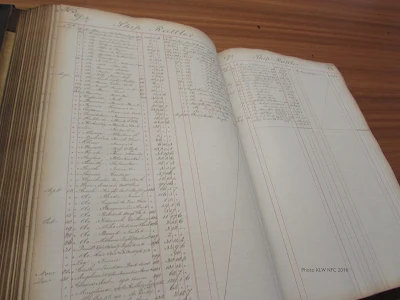


Brooks' cleanly kept and organized ledger

Above: the index to the ledger below.

Records of Robert Brooks and Co. NLA MS 2381
Photos copyright © KLW NFC Imprint 2016
THE MITCHELL LIBRARY STATE LIBRARY of NSW

Robert Towns & Co - Records, 1828-1896
SLNSW Call Number MLMSS 307
184: Papers, including business letters from Robert Lodge and Robert Brooks to Robert Towns and Co; cargo manifestoes, the 'Eagle', 'Robert Matthews', 'Parrock Hill'; passenger list 'Duke of Roxburgh'
Below: Memorandum of Agreement between Captain Edward Goldsmith of the Parrock Hall and agents J. Woodall, and W. Samson to supply labour to load wool at Sydney dated 27th November 1844:

Robert Towns & Co - Records, 1828-1896 Call Number MLMSS 307
Photos copyright © KLW NFC Imprint 2016
TRANSCRIPT
Memorandum of Agreement between Captain Edward Goldsmith of the Barque Parrock Hall on the one part, and J. Woodall and W. Samson, Stevadores, of Sydney, on the other part, that is to say the said J. Woodall, and W. Samson do hereby agree to stow the said Vessell with Wool, [inserted - and other Merchandise], and to find Press, Screws, Planks, Samson Posts, Toms, Hand-hooks, Lashings and a foreman and find all Labour at 4s per Bale the whole of the Cargo to be taken from the Shore and hoisted on board by the Stevendores with the useof the Ship's boatsBelow:
No allowance for Broken Stowage of any Kind - Bones - Hoofs and Horns being of that description
The terms of this agreement is to this effect - the whole of the Labour to be performed by the seven Stevadores without any extra change beyond the sum above stated and to the entire satisfaction of the said Captain Goldsmith
We also agree to stow the Dead Weight on board the above Vessel, at Nine Pence per Ton. Ship finding labour ....
Witness our hands this Twenty seven day of November One thousand eight hundred and forty-four
We also agree to Employ what men you have to spare at the rate of 2/5 pr day and to ? at the rate of 2/6 etc etc [ page torn ]
For Woodall and Samson
signed R Towns
Jno Wood etc
"Manifest Parrock Hall London to Sydney Freight Payable in Coly"

Manifest of cargo per the ship Parrock Hall to Sydney


Plan of cabins for the A1 vessel Dawstone, register 495 tons
"Apply to Devitt & Moore"

Robert Towns & Co - Records, 1828-1896 Call Number MLMSS 307
184: Papers, including business letters from Robert Lodge and Robert Brooks to Robert Towns and Co; cargo manifestoes, the 'Eagle', 'Robert Matthews', 'Parrock Hill'; passenger list 'Duke of Roxburgh'
Photos copyright © KLW NFC Imprint 2016
The ship "Parrock Hall" to Sydney
On Tuesday, November 5th, 1844, Captain Edward Goldsmith sailed into Sydney Harbour in command of the merchant barque the Parrock Hall, 425 tons, departing Portsmouth on July 22, 1844, bringing mail, cargo and passengers via the Cape of Good Hope. The voyage was exceptionally fast (105 days). According to The Shipping Gazette and Sydney General Trade List of Nov. 9th, "she had a fine passage" and on the way, "she did not speak any thing." The ship may have acquired its name from the old manor of Robert de Parrock, where Parrock Avenue and Parrock Road are now located in Gravesend, Kent, UK. Parrock Hall was built by Peter Moulson, Lord of the Manor of Milton, in 1761, and by 1821 it was owned by Colonel Dalton. In 1991, Parrock Hall, a Grade II listed building, was said to be in a dilapidated state with calls for its preservation.
"A very fine day" was how journalist and playwright David Burn described Tuesday, November 5th 1844, in his diary (SLNSW Call No. B 190 / 2). He was watching the signals on Flagstaff Hill, Millers Point, for news of Captain Goldsmith's arrival in Sydney Harbour. The Marryat flag for the Parrock Hall, No. 9376, signalled the barque as it sailed on towards Fotheringham's Wharf "in the Cove" where it would remain until being cleared out for London on January 15th, 1845.
Read the rest of this post here about Captain Goldsmith and David Burn.
IMPORTS November 1844 at Sydney per the Parrock Hall, barque, 424 tons, Captain Goldsmith, from London ...
Source: The Sydney Morning Herald Wed 6 Nov 1844 Page 2 IMPORTS.
TRANSCRIPT
IMPORTS.
November 5.Parrock Hall, barque, 424 tons, Captain Goldsmith, from London : 1 box apparel, A. Gravely; 6 tierces tobacco, Thomas Smith and Co. ; 3 casks lead, Watkin ; 28 kegs 12 tierces tobacco, Smith and Campbell; 30 hogsheads and 50 barrels beer, and 100 casks bottled beer, Lyall, Scott, and Co.; 12 cases, 1 cask, 5 bales, 60 coils line, and 6 coils rope, 20 firkins, 4 casks oil, and 1 box, F. Whit-worth; 1 case, F. Mitchell; 4 cases, J. and S. Willis; 4 bales slops, 33 tierces tobacco, 4 bales slops, 20 trunks shoes, and 8 bales shirts, Lamb and Parbury; 1 case apparel, and 1 box candles, Bishop of Australia ; 2 boxes black lead, Ray and Glaister; 43 hogsheads rum, R. Towns ; 1 case silver plate, Miss Howe ; 1 case silver plate, R. Campbell, junior; 100 hogs-heads beer, 100 casks bottled beer, 1 case, and 4 bales, Flower, Salting, and Co. ; 1 case ap-parel, J. Purser; 2 cases apparel, and 3 bales, Rev. Dr. Ross ; 1 case, W. Walker and Co. ; 1 parcel books, Colonel Shadforth ; 8 trusses and 1 trunk, J. J. Giblett ; 7 packages plate glass, Solomon ; 5 boxes soap, Miss Wright; 3 bales and 8 cases, M. Joseph; 1 case, Quaife ; 1 case books, W. A. Colman; 1 case and 1 trunk, J. G. Raphael, 1 case, Fullerton; 1 case, Mr. Hamilton ; 8 bales, 19 cases, H. G. Smith ; 33 cases and 39 bales, 29 1/2 tierces, and 5 tierces tobacco, Griffiths, Gore, and Co. , 1 case, D. Davis ; 1 case, J. F. Milne , 2 cases, 2 trunks, 1 bale, Swain, Webb, and Co ; 1 case, G Mason ; 45 coils rope, A. Fothering-ham ; 1 case, 10 bales, 5 trunks, T. Smith and Co ; 30 hogsheads beer, 3 cases whips, E. Goldsworth ; 3 bales and 3 cases, R. Ramsay, sen., and Co. ; 1 case preserves, J. Parnell; 8 cases cottons, Dreutler and Wagner ; 38 cases Portugal wine, E. C. Weekes ; 1 box boots, Judge Stephen ; 36 bales linens, 8 cases sta-tionery, 28 casks shoes, I bundle measures, 4 bundles tarpaulins, 9 bundles, 38 table boards, 79 kettles, 52 pots, 50 shovels, 27 pieces iron, 400 ash felloes, 12 spades, 3 coils rope, 1 hand-cart, 100 fathoms cable, 4 gun-carriages, 4 handspikes, 16 bundles iron, 5 baskets oil, 10 cases iron work, Government stores ; 1 case (a carriage), 1 case hardware, 34 casks bottled, and 1 hogshead beer, order. R. Towns, agent.

Title Robert Towns, merchant and entrepreneur, 1873 / photographer Freeman, late Oswald Allen
Creator Freeman Brothers
Call Number P1 / 1797
Digital Order No. a4364097
Mitchell Library State Library NSW
Loading the "Parrock Hall" for London
Source: The Sydney Morning Herald (NSW : 1842 - 1954) Mon 9 Dec 1844 Page 1 Advertising
FOR LONDON
THE very fast-sailing A.1. 12 years' Ship
PARROCK HALL, 435 tons register, Goldsmith,
Commander. This vessel is now taking in
cargo, and being a chartered ship, will sail
early in January.
For freight or passage, having superior ac-
commodation for cabin and steerage passen-
gers, apply on board, or to
ROBERT TOWNS,
OR,
GILCHRIST AND ALEXANDER.
Sydney, November 27. 7295
January 15th, 1845:
TRANSCRIPT
January 15. Parrock, Hall, barque, Captain Goldsmith for London. Passengers - Mr. and Miss Mead, Mr. Wade, Dr. Johnson, Mr. and Mrs Gard, Misses Agnes, Elizabeth, and Emma Gard, Master William Gard, Mr. Ashford, Mr. Atkins, Mr. R. Bailey, Master Conolly, Mr. John Whaling, Mr. and Mrs. Donovan and son, mr. and Mrs. Curtis and five children, Mr. John Hazard, Mr. Henry Granhow, Mrs Luke, Mrs. Chapman, Mr. George West. Mr. Joseph Hoyle, Mr. Charles Swindels, Mr. W. Copeland, Mrs. Copeland, and Mr. W. Taylor.
EXPORTS January 11th, 1845
Source; The Shipping Gazette and Sydney General Trade List (NSW : 1844 - 1860) Sat 11 Jan 1845 Page 10 VESSELS LAID ON FOR ENGLAND.
Parrock Hall, barque, 425 tons, Goldsmith ;
401 casks tallow, 1082 bales wool, 2 tons
dyewood, 7 tons copper ore, 4 tons man-
ganese, 10 tons horns and bones, 2 casks
neats'-foot oil, and 200 salted hides, on board.
Full ship.
Exports: January 11th, 1845, the Parrock Hall and January 13th, the Louisa.
TRANSCRIPT
EXPORTS
January 11. – Parrock Hall, barque, Captain Goldsmith, for London: 222 bales wool, 19 casks tallow, Gilchrist and Alexander; 21 bales wool, Brown and Co.; 155 bales wool, 63 casks tallow, 3 casks hog’s lard, 1 case apparel, 1 case of specimens of natural history, Thacker, Mason and Co.; 248 bales wool, Donaldson, Dawes, and Co.; 186 bales wool, W. Walker and Co.; 43 casks tallow, C. Appleton and Co.; 137 casks tallow, 2 casks neats foot oil, 240 hides, Robert Towns; 20 casks tallow. Thomas Smith and Co., 9 tons copper ore, 3 tons manganese, 10 cwt. dyewood, Beattie and Taylor; 3 casks ironmongery, B. Boyd and Co.; 1 case jewellery, 4 casks and 8 cases ironmongery, R. Lamb; 10 tons drywood, C. Ambercrombie; 12 tons bones, R. Hill.

Robert Brooks: profits from Parrock Hall voyage and payment to Captain Goldsmith
Records of Robert Brooks and Co. NLA MS 2381
Photos copyright © KLW NFC Imprint 2016
The Competition: Montefiore Bros.
"The Messrs Montefiore have for a long time been endeavouring to become large importers of Wool into this country, and have adopted a system of advancing on Wool while growing on the Sheep's back, this extraordinary way of doing business has led to their present embarrassment".Robert Brooks, 1841
From: Settlers and the Agrarian Question: Capitalism in Colonial Australia
Philip McMichael, Cambridge University Press, 23 Dec. 2004 - History - 324 pages

Sydney Cove 1850s
SLNSW Ref: a12871h

Towns Wharf, numbered as Pier 8, and the Port Authority building, Towns Place, Sydney Harbour NSW
Next to the Barangaroo development, Millers Point
Photos copyright © KLW NFC 2013

Towns Wharf, numbered as Pier 8, and the Port Authority building, Towns Place, Sydney Harbour NSW
Next to the Barangaroo development, Millers Point
Photos copyright © KLW NFC 2013
For a comprehensive history of the Barangaroo south archeological excavations 2012, view this report. Casey & Lowe report to Lend Lease.
Google map 2017 showing Towns Place, Sydney Harbour
Old Maps: Towns Wharf
Detail showing Robert Towns wharf and offices
(18--]). [Wharves at Millers Point, Walsh Bay, Sydney]
https://nla.gov.au/nla.obj-230009231
Detail of map of Sydney showing Towns Wharf etc 1865
S.T. Leigh & Co., printer. (1865). New plan of Sydney, N.S.W
https://nla.gov.au/nla.obj-416707354
A contract: Robert Towns and his Chinese servant
These articles of agreement were signed between Robert Towns and Kaw Hoe, immigrant from Amoy in the Empire of China in 1852. Kaw Hoe was contracted to Towns for five years in the capacity of Shepherd Farm and General Servant and Labourer
The Mitchell Library State Library of NSW
Robert Towns & Co - Records, 1828-1896Call Number MLMSS 307
Photos copyright © KLW NFC Imprint 2016
The "Rattler" to Hobart and for London
Before taking command of the Rattler in July 1846, Captain Edward Goldsmith was in command of the barque Angelina on the return voyage to London from the round trip to Sydney NSW when he had a narrow escape. The Angelina, 434 tons, laden with produce and 36 passengers, had cleared the Heads at Sydney on February 22nd 1846, but two weeks later, on 7th March as the barque entered the Southern Ocean nearing Cape Horn, the Angelina was struck by an iceberg, sustaining damage to the foredeck and losing the bowsprit. Delayed a week at Rio de Janeiro for repairs, Captain Goldsmith sailed the Angelina safely back past Portsmouth on the 4th July 1846. Barely twenty days back on shore in London, he was ready – and so was his wife Elizabeth Goldsmith – to set sail again. He took command of the Rattler, new off the stocks, on 24th July 1846, his sights set once more for Van Diemen’s Land.
Elizabeth Goldsmith (nee Day, 1802-1875) sailed on the Rattler‘s maiden voyage with her husband Captain Edward Goldsmith in command, departing London on 24th July 1846, arriving at Hobart, Van Diemen’s Land (Tasmania) on 11th November 1846. General cargo included a consignment of equipment and uniforms for the 65th Regiment for government Ordnance Stores, fine clothing and furnishings for sale by local merchants, two pianos, alcohol and foodstuffs, stationery, personal effects etc etc (see consignees lists below). The Goldsmiths stayed two months during a glorious summer in Hobart, departing on the Rattler, 21st January 1847, with nineteen passengers and a cargo of whale products and wool destined for London.
GOODS LANDED at HOBART Nov. 1846

Goods landed, consignees' names, signed Edwd Goldsmith
Archives Office Tasmania
Item Number: CUS36/1/442 Images 48,49,50
Detail of Signature of Captain Edward Goldsmith,
Arrival at Hobart, November 1846
Goods landed, consignees' names, signed Edwd Goldsmith
Archives Office Tasmania
Item Number: CUS36/1/442 Images 48,49,50
LOADING at HOBART for LONDON
The Courier (Hobart, Tas. : 1840 - 1859) Sat 19 Dec 1846 Page 1 Classified Advertising
"... her wool engaged..."

The Great Wool Floor at the London Docks 1840s
Source: The Victorian Web

Per the Rattler for London, Goldsmith master
The growth and produce of Van Diemens Land
T. Chapman, exporter 18 Jan 1847

Honourable T D Chapman
Description:1 photographic print [undated, unattributed]
ADRI: NS407-1-19
Source: Archives Office of Tasmania
ADB Biography
https://adb.anu.edu.au/biography/chapman-thomas-daniel-3195
RELATED POSTS main weblog

- Captain Edward Goldsmith's cargo ex London Docks per Rattler 1850
- Captain & Mrs Elizabeth Goldsmith: Rattler's maiden voyage 1846
- Captain Goldsmith, the Parrock Hall, & playwright David Burn 1844-45
- Captain Edward Goldsmith's grave at Chalk Church Kent
- A Christmas story: Captain Goldsmith, Charles Dickens and the Higham mail box
- Captain Edward Goldsmith and the patent slip 1855
- Captain Edward Goldsmith, the patent slip, and the McGregor family
- Testimonial to Captain Edward Goldsmith 1849
- The Master Mariner in-laws: Captains Goldsmith, Day and Axup
- Newspaper list Captain Edward Goldsmith at TROVE (NLA)
- Robert Brooks & Co. NLA summary of holdings - pdf
- Robert Towns & Co - Records, 1828-1896 State Library NSW
- Parliamentary Debates: The Navigation Bill 1849
- Ranulph Dacre Australian Dictionary of Biography
- Ranulph Dacre biography Encyclopedia of New Zealand
- Barangaroo South preliminary report 2012
In memory of Frank Broeze (18 August 1945 – 4 April 2001), professor of history at the University of Western Australia. His special area of interest was maritime history.


















